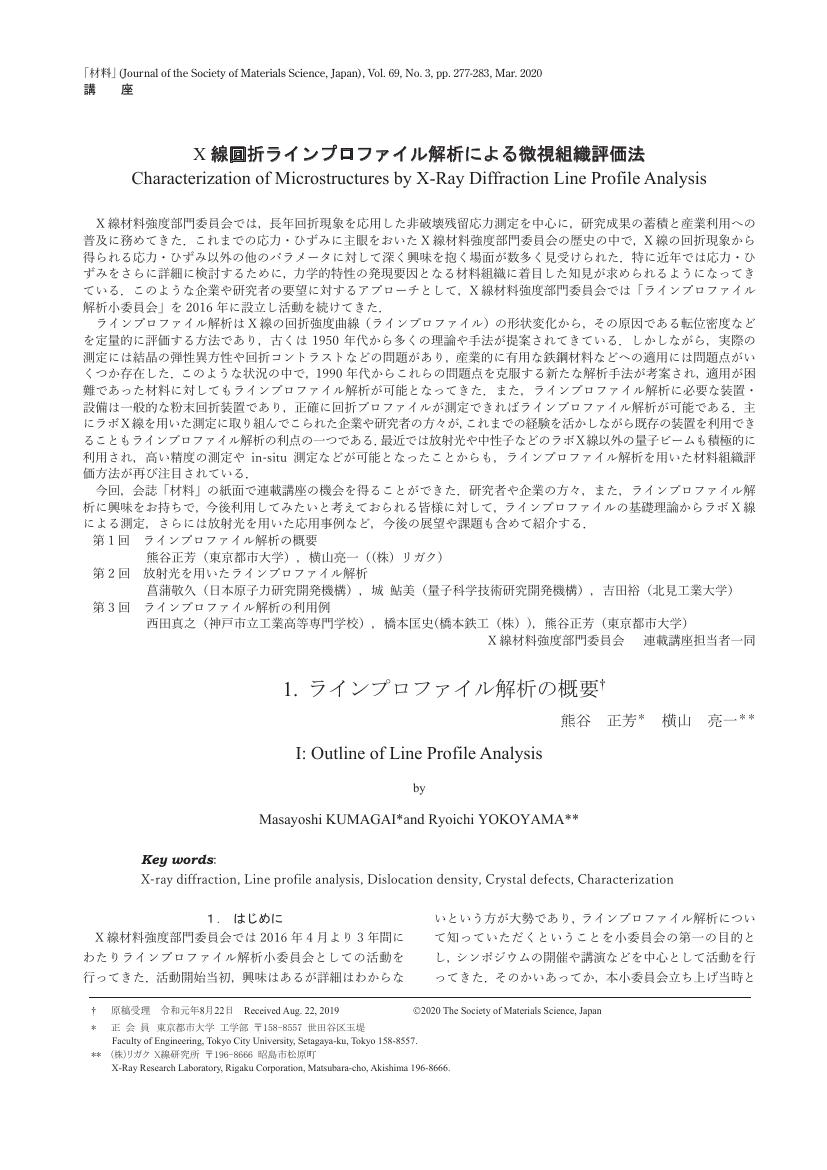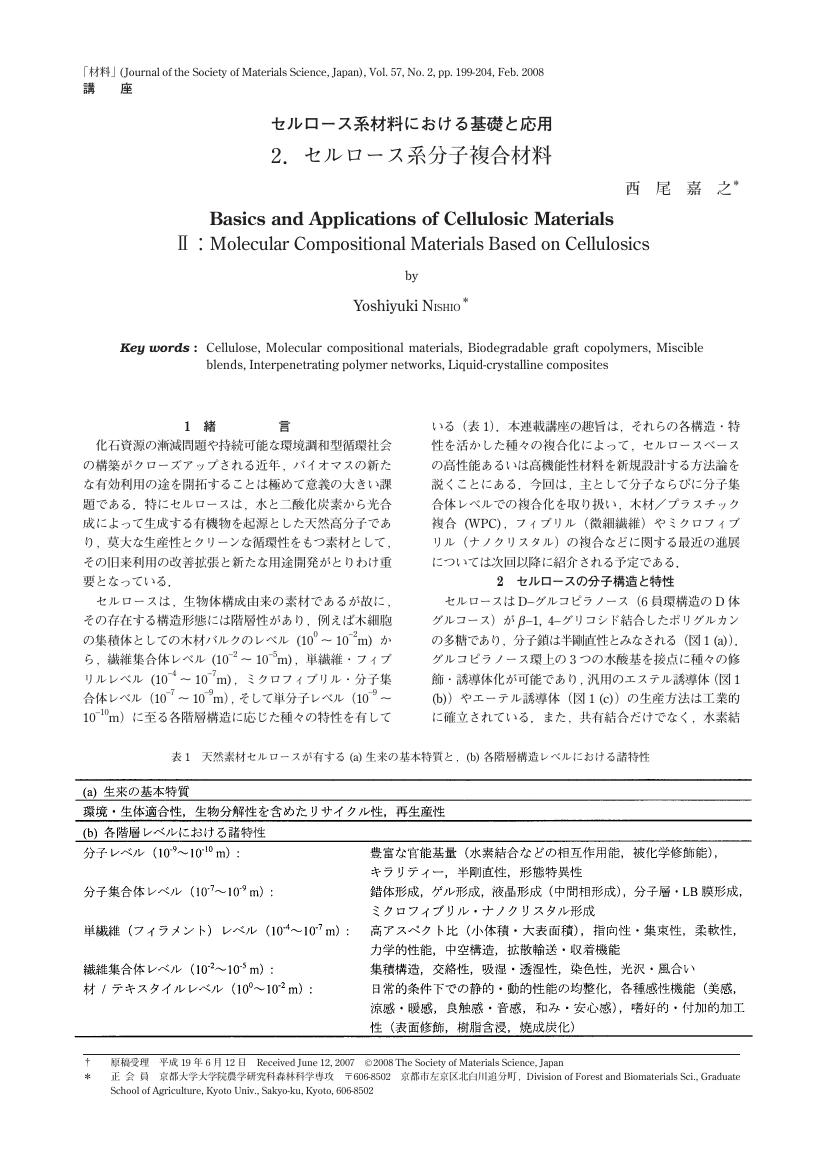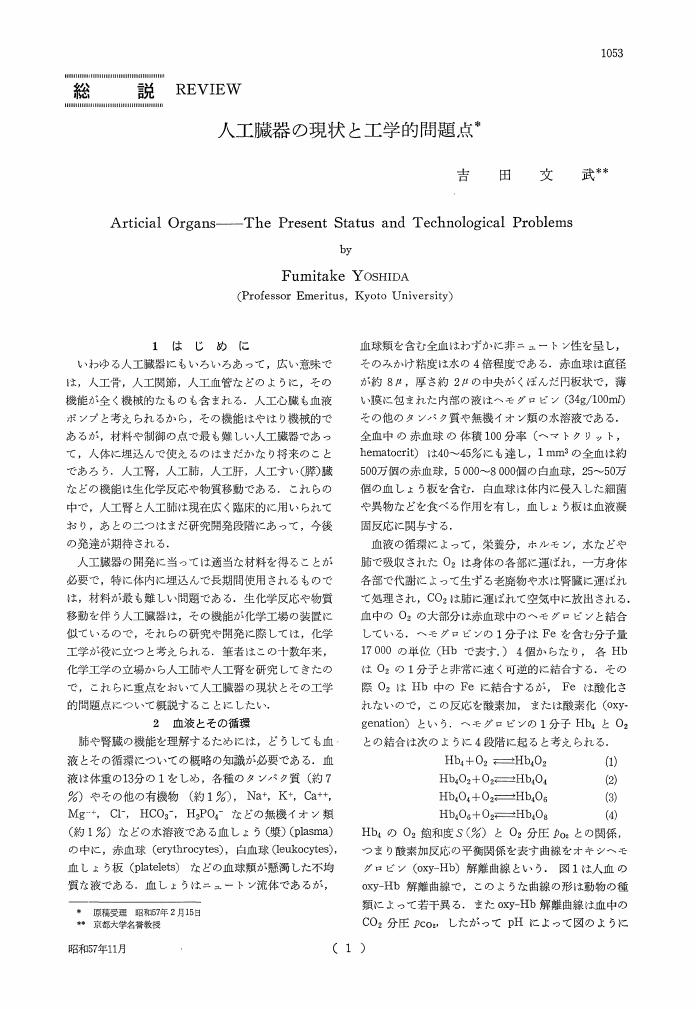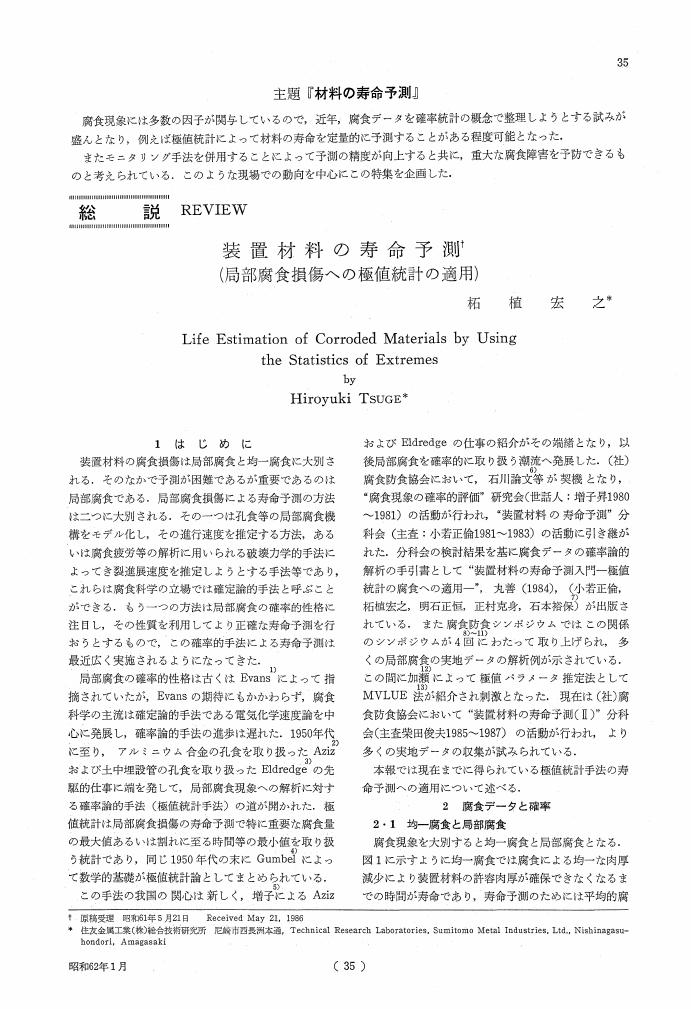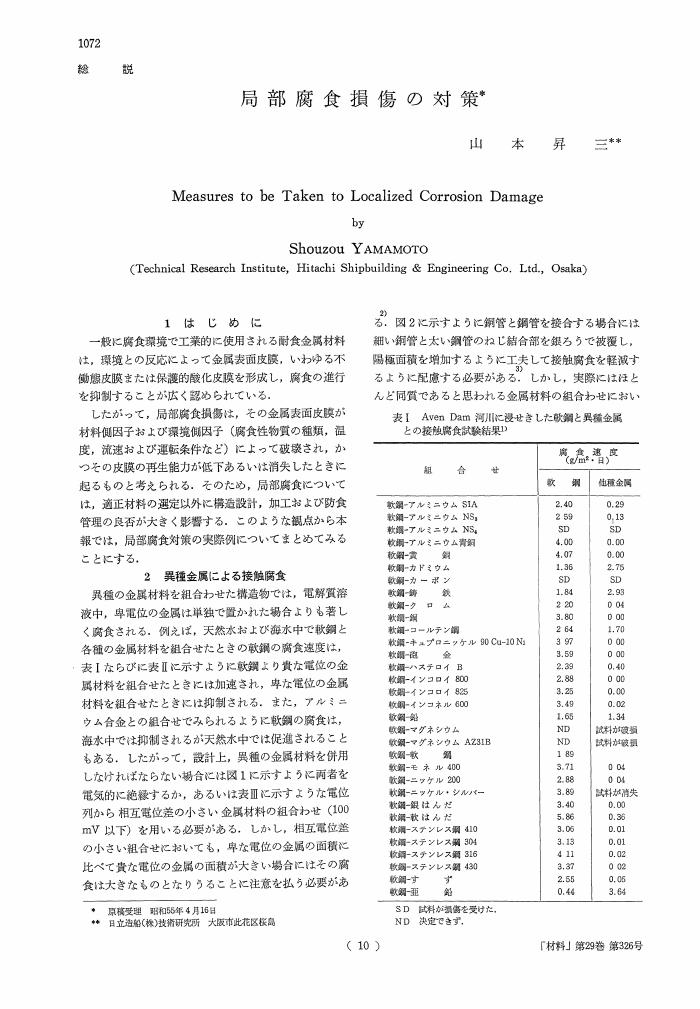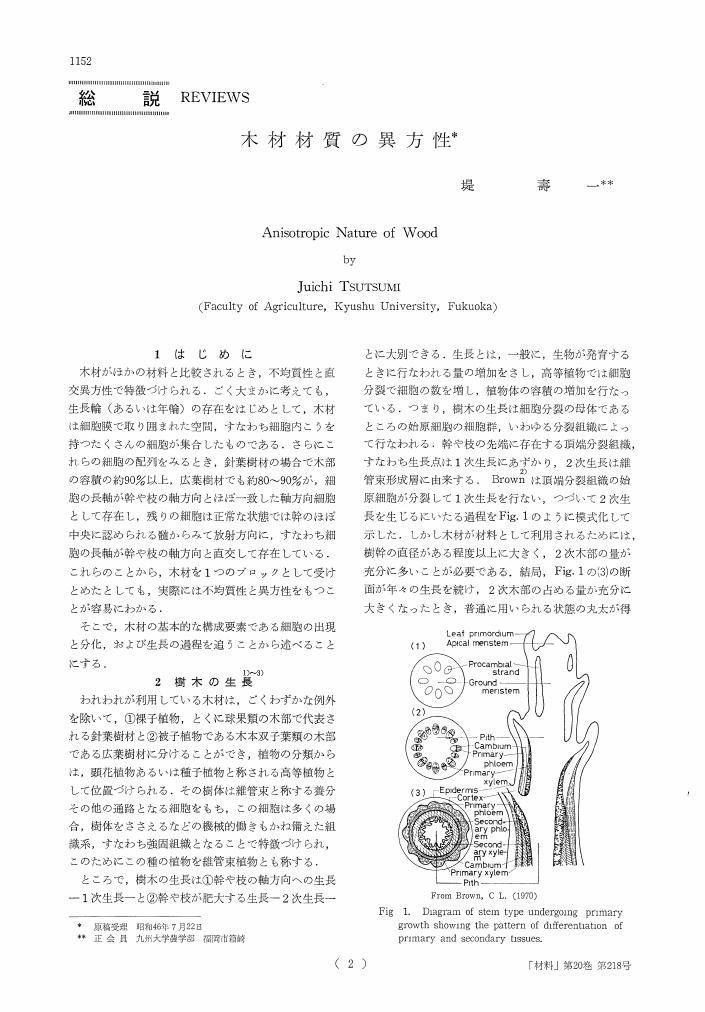1 0 0 0 OA X線回折ラインプロファイル解析による微視組織評価法 1.ラインプロファイル解析の概要
- 著者
- 熊谷 正芳 横山 亮一
- 出版者
- 公益社団法人 日本材料学会
- 雑誌
- 材料 (ISSN:05145163)
- 巻号頁・発行日
- vol.69, no.3, pp.277-283, 2020-03-15 (Released:2020-03-20)
- 参考文献数
- 40
- 被引用文献数
- 2
1 0 0 0 OA 人為的促進老化処理したヒノキ材の切削抵抗
- 著者
- 横山 操 矢野 健一郎 藤原 裕子 藤井 義久 川井 秀一
- 出版者
- 公益社団法人 日本材料学会
- 雑誌
- 材料 (ISSN:05145163)
- 巻号頁・発行日
- vol.55, no.8, pp.772-776, 2006 (Released:2006-08-20)
- 参考文献数
- 7
The purpose of this study was to propose a method of determining the aging of wood by measurement of cutting resistance. To clarify the effect of the aging of wood on the cutting resistances, it is necessary to focus on the way the restorators judges the age of wood material by taking into consideration the cutting process and the way of using the chisels (nomi).In this paper, aging is defined as “slow oxidation caused by oxygen in the air”. Base on the temperature-time conversion law, an accelerated aging test was performed by heat treatment at 180°C for 0, 120, 300, 600, 720, 2160, 3600, 5040, 7200minutes respectively to obtain different levels of accelerated aging wood samples.When restorators of Buddhist sculptures restorate ancient statues, they face various qualities of timber, according to the tree species and the age of the material used for the statue. They make decisions by visual inspection. Thus the experience and judgement of the Japanese restorators is one of the key conditions to measure the cutting resistance and types of chip formation.The orthogonal cutting test of cross, radial and tangential section were made to examine the relationships cutting resistances and treatment time of the accelerated aging of wood materials. The results were summarized as follows :1) The cutting resistances fell with increasing the accelerated aging treatment time. The cutting resistances dropped sharply in the early stages up to 1000 minutes treatment, and then reduced by 80% at 7200minutes treatment.2) The types of chip formation changed from flow type to powder with increasing the accelerated aging treatment time.3) The forces in cross sectional cutting with clearance angle 5° were three times in value with clearance angle 1°. The forces in orthogonal cutting test in radial and tangential section were almost same in value at clearance angle 1° and 5°.
1 0 0 0 OA 加熱されたコンクリートの物理的性質の変化
- 著者
- 原田 有
- 出版者
- 公益社団法人 日本材料学会
- 雑誌
- 材料試験 (ISSN:03727971)
- 巻号頁・発行日
- vol.6, no.40, pp.15-19, 1957-01-15 (Released:2009-07-09)
1 0 0 0 OA はんだ接合部の熱疲労強度の評価
- 著者
- 宮崎 政行 吉岡 純夫 土方 明躬
- 出版者
- 公益社団法人 日本材料学会
- 雑誌
- 材料 (ISSN:05145163)
- 巻号頁・発行日
- vol.30, no.331, pp.330-335, 1981-04-15 (Released:2009-06-03)
- 参考文献数
- 9
- 被引用文献数
- 3 3
This paper presents the low cycle fatigue properties of two kind of solder materials and evaluation method of thermal fatigue life for solder joints. Thermal stress at the solder joint of semiconductor devices subjected to thermal cycle is discussed. Thermal fatigue test results of semiconductor devices are compared with the predicted life obtained from the low cycle fatigue strength of solder.The results obtained are as follows:(1) The mechanical shear properties depend on the test temperature and strain rate for two solder materials (60 Pb-40 Sn and 88 Pb-10 Sn-2 Ag). The low cycle fatigue strength of these solder materials can be expressed by equation (1). This equation (1) is valid for the test temperature range from 20°C to 135°C and the hold time up to one hour.ΔγT·Nf0.85=14.0 (1)where ΔγT and Nf represent the total strain amplitude and the number of cycles to failure, respectively.(2) By taking the nonlinear stress-strain properties into account, a theoretical analysis was made to obtain the thermal shear strain in the solder joint. The effects of major structural dimensional factors on shear strain were clarified.(3) Thermal fatigue life tests of semiconductor devices were conducted and the resistance change method was adopted to detect the fatigue failure of devices. The predicted life was found to be in a rather safety side compared with the measured life.
1 0 0 0 OA 金属細線の疲労損傷の交流電位差法による検出とその実体のデジタルマイクロスコープによる観察
- 著者
- 中井 善一 橋本 晃久 竹谷 彰彦
- 出版者
- 公益社団法人 日本材料学会
- 雑誌
- 材料 (ISSN:05145163)
- 巻号頁・発行日
- vol.54, no.10, pp.1047-1051, 2005 (Released:2006-04-07)
- 参考文献数
- 10
- 被引用文献数
- 1 1
Fatigue tests of thin wires made of commercially pure iron or aluminum were conducted in air. The fatigue damage of the Materials was successfully measured with either an A. C. potential method or a digital microscope. For the A. C. potential method, constant current of 600 mA with 888 Hz was applied to the specimen. In pure iron, the value of electric potential was increased for a specimen whose diameter was 0.20 mm, however it was almost constant for a specimen of 0.60 mm in diameter. In pure aluminum, the value of potential was increased for every specimen diameter. In this Material also the change of A. C. potential was larger for smaller specimens. The change of A. C. potential value was detected before the specimen deformation observed with the digital microscope.Two types of fracture morphology were observed with digital microscope. Those were with or without fatigue cracks. In the latter case, the specimen was necked at the final stage of fatigue process.
1 0 0 0 OA 2. セルロース系分子複合材料
- 著者
- 西尾 嘉之
- 出版者
- 公益社団法人 日本材料学会
- 雑誌
- 材料 (ISSN:05145163)
- 巻号頁・発行日
- vol.57, no.2, pp.199-204, 2008 (Released:2008-02-16)
- 参考文献数
- 16
1 0 0 0 OA ZrOCl2・8H2OおよびSi(OC2H5)4からのジルコン系粉末の合成
- 著者
- 管野 善則 鈴木 正
- 出版者
- 公益社団法人 日本材料学会
- 雑誌
- 材料 (ISSN:05145163)
- 巻号頁・発行日
- vol.37, no.415, pp.378-384, 1988-04-15 (Released:2009-06-03)
- 参考文献数
- 21
- 被引用文献数
- 1 1
Zircon powders were prepared by means of a sol-gel method from an equimolar mixed solution of Si(OC2H5)4 and ZrOCl2·8H2O dissolved by hot ethanol, and the crystallite growth and phase change in the powders caused by heat treatment were investigated. The formation mechanism and the thermal-decomposition temperature of zircon powders were discussed on the basis of X-ray diffractometry. The results obtained are as follows:(1) The starting temperature of zircon formation in the as-dried powders without grinding treatment was ca. 1500°C and the rate of formation was very slow. On the other hand, the formation of zircon was accelerated by the grinding treatment of the as-dried powders (the starting temperature was ca. 1200°C), and especially the formation reaction was remarkably promoted in the temperature range of 1300-1450°C with the aid of “Hedvall effect” induced by the crystallization of amorphous silica.(2) It was considered that the promotion effect of zircon formation by grinding was attained by the breakdown of siloxane polymers. The formation of zircon took place via the solid-state reaction of tetragonal ZrO2 and SiO2, and silica changed its phase from amorphous (lower temperature) to transition and then to crystal-like (higher temperature) with heat-treatment temperature.(3) It was pointed out that the thermal decomposition temperature of high purity zircon was higher than that reported in literature (1676°C).
- 著者
- 大場 恵史 栗田 典之 栢森 豊 田島 雄二 高橋 良彰 野田 一郎 石田 康行 大谷 肇 柘植 新
- 出版者
- 公益社団法人 日本材料学会
- 雑誌
- 材料 (ISSN:05145163)
- 巻号頁・発行日
- vol.51, no.12, pp.1335-1340, 2002-12-15 (Released:2009-06-03)
- 参考文献数
- 17
Structural information of the styrene-ethylene glycol dimethacrylate (St-EGDM) cross-linked copolymers obtained by Pyrolysis-gas chromatography (Py-GC) was compared with those obtained by conventional dynamic mechanical analysis and swelling measurement. The monomer ratios of St/EGDM in the highly cross-linked polymers determined by Py-GC were in fairly good agreement with the monomer feed ratios, while those estimated indirectly by the conventional methods were considerably higher than the feed ratios. Furthermore, the St contents estimated by Py-GC for the polymer samples obtained in low conversion were found to be extremely lower than the feed ratios suggesting that the cross-linking domains would be formed at the early stage of the polymerization. These observations suggest that the network structures of the cross-linked polymers in this work would be inhomogeneous to a great extent mainly due to the potential presence of the cross-linking domains in which EGDM monomer units are localized.
1 0 0 0 OA 耐熱性エポキシ樹脂およびそのCFRP積層板の機械的性質の時間-温度依存性
- 著者
- 笠森 正人 大塚 猛 新保 實 宮野 靖
- 出版者
- 公益社団法人 日本材料学会
- 雑誌
- 材料 (ISSN:05145163)
- 巻号頁・発行日
- vol.41, no.463, pp.465-469, 1992-04-15 (Released:2009-06-03)
- 参考文献数
- 15
- 被引用文献数
- 5 4
This paper is concerned with the time and temperature dependences of the static flexural behavior in CFRP laminates consisting of high temperature epoxy matrix and satin woven carbon fibers. Dynamic viscoelastic tests for neat resin and three-point bending tests for CFRP laminates were carried out under various loading rates and temperatures. The results obtained are summarized as follows;(1) The mechanical behavior of epoxy resin used was remarkably dependent upon time and temperature even in the vicinity of room temperature that is sufficiently lower than the glass transition temperature Tg.(2) The static flexural strength of CFRP laminates was also remarkably dependent upon time and temperature over a wide range of temperature even below Tg.(3) The time and temperature dependences of the static flexural strength of CFRP laminates was dominated by the mechanical behavior of matrix resin.
1 0 0 0 OA 漬物の保存性に及ぼす高圧処理の効果
- 著者
- 松本 正
- 出版者
- 公益社団法人 日本材料学会
- 雑誌
- 材料 (ISSN:05145163)
- 巻号頁・発行日
- vol.45, no.3, pp.268-273, 1996-03-15 (Released:2009-06-03)
- 参考文献数
- 14
1 0 0 0 OA 材料の高速変形と破壊
- 著者
- 田中 吉之助 黒川 知明
- 出版者
- 公益社団法人 日本材料学会
- 雑誌
- 材料 (ISSN:05145163)
- 巻号頁・発行日
- vol.40, no.451, pp.495-502, 1991-04-15 (Released:2009-06-03)
- 参考文献数
- 14
1 0 0 0 OA 微小き裂の下限界応力拡大係数幅ΔKthに及ぼす硬さとき裂形状の影響
- 著者
- 村上 敬宜 遠藤 正浩
- 出版者
- 公益社団法人 日本材料学会
- 雑誌
- 材料 (ISSN:05145163)
- 巻号頁・発行日
- vol.35, no.395, pp.911-917, 1986-08-15 (Released:2009-06-03)
- 参考文献数
- 67
- 被引用文献数
- 28 63
The dependence of ΔKth on crack size and material properties under stress ratio R=-1 was studied on various materials and microstructures. The values of ΔKth for all the materials investigated were standardized with one geometrical and one material parameter.The geometrical parameter, √area, is the square root of the area which is occupied by projecting defects or cracks onto the plane normal to the maximum tensile stress. The relationship between ΔKth and √area is expressed as follows:ΔKth∝(√area)1/3 (a)The most relevant material parameter to standardize the data was the Vickers hardness, and the following relationship was obtained:ΔKth∝(HV+C) (b)The constant C in Eq. (b) reflects the difference of nonpropagation behavior of small cracks in soft and hard metals.By combining Eqs. (a) and (b), the following equations were derived for predicting ΔKth and the fatigue limit σω of cracked members.ΔKth=3.3×10-3(HV+120)(√area)1/3 (c)σω=1.43(HV+120)/(√area)1/6 (d)where the units are ΔKth: MPa·m1/2, σω: MPa, √area: μm and HV: (kgf/mm2). Equations (c) and (d) are applicable to a crack having √area approximately less than 1000μm.
1 0 0 0 OA 悪夢のようなクリスマスイブ前夜
- 著者
- 金子 健太郎
- 出版者
- 公益社団法人 日本材料学会
- 雑誌
- 材料 (ISSN:05145163)
- 巻号頁・発行日
- vol.68, no.9, pp.731-732, 2019-09-15 (Released:2019-09-20)
1 0 0 0 OA 人工臓器の現状と工学的問題点
- 著者
- 吉田 文武
- 出版者
- 公益社団法人 日本材料学会
- 雑誌
- 材料 (ISSN:05145163)
- 巻号頁・発行日
- vol.31, no.350, pp.1053-1060, 1982-11-15 (Released:2009-06-03)
- 参考文献数
- 14
1 0 0 0 OA 装置材料の寿命予測
- 著者
- 柘植 宏之
- 出版者
- 公益社団法人 日本材料学会
- 雑誌
- 材料 (ISSN:05145163)
- 巻号頁・発行日
- vol.36, no.400, pp.35-46, 1987-01-15 (Released:2009-06-03)
- 参考文献数
- 18
- 被引用文献数
- 7 3
1 0 0 0 OA 局部腐食損傷の対策
- 著者
- 山本 昇三
- 出版者
- 公益社団法人 日本材料学会
- 雑誌
- 材料 (ISSN:05145163)
- 巻号頁・発行日
- vol.29, no.326, pp.1072-1084, 1980-11-15 (Released:2009-06-03)
- 参考文献数
- 38
1 0 0 0 OA 海虫食害研究の現状
- 著者
- 馬渡 静夫
- 出版者
- 公益社団法人 日本材料学会
- 雑誌
- 材料 (ISSN:05145163)
- 巻号頁・発行日
- vol.14, no.143, pp.638-642, 1965-08-15 (Released:2009-06-03)
1 0 0 0 OA ゴム変性エポキシ樹脂の相分離構造と機械的性質
- 著者
- 村上 惇 松下 裕臣 吉識 忠継 新保 正樹
- 出版者
- 公益社団法人 日本材料学会
- 雑誌
- 材料 (ISSN:05145163)
- 巻号頁・発行日
- vol.34, no.384, pp.1099-1104, 1985-09-15 (Released:2009-06-03)
- 参考文献数
- 27
- 被引用文献数
- 2 2
The morphology of phase-separation and the mechanical properties of amine cured rubber-modified epoxy resins were investigated.The results of the dynamic mechanical properties and the microscopic observations indicated that the epoxy-rich matrix phase was plasticized by the dissolved rubber and the rubber-rich domains were dispersed homogeneously in the epoxy-rich matrix.The rubber-modification of epoxy resins enhanced the fracture toughness against crack initiation and caused the crack arrest. The size of the plastic-deformed region at the crack tip was correlated well with the fracture toughness against crack initiation according to Dugdal's equation.From the fatigue crack propagation (FCP) tests at a low frequency it has been shown that the presence of rubber domains introduces the interfacial debonding between the domain and the matrix as the result of stress response, which promotes the FCP at the low stress intensity factor range.
1 0 0 0 OA 巨大フラーレンの構造の位相幾何学的考察
- 著者
- 中野 詔彦 長谷川 澄子
- 出版者
- 公益社団法人 日本材料学会
- 雑誌
- 材料 (ISSN:05145163)
- 巻号頁・発行日
- vol.42, no.480, pp.1032-1038, 1993-09-15 (Released:2009-06-03)
- 参考文献数
- 3
The structures of giant fullerenes have been considered from the topological view point. As the fullerenes are formed of the pentagonal rings and hexagonal rings, Euler's theorem in the topology shows that 12 pentagonal rings are neccessary though the number of hexagonal ones is arbitrary for the formation of the closed polyhedron. This restraint predicts that symmetric giant fullerenes have the following shapes: the icosahedral-shaped, the tetrahedral-shaped, the pentagonal prism-shaped and the hexagonal prism-shaped ones. We have classified the icosahedral-shaped and the tetrahedral-shaped ones into three systems, respectively, and the pentagonal prism-shaped and the hexagonal prism-shaped ones into two systems, respectively, thus totaling ten systems. We have formulated the equations for calculating the number of atoms n in the giant fullerenes Cn. The results indicate that the forming of the round-shaped giant fullerenes requires the sets of heptagonal and pentagonal rings while keeping (the number of pentagonal rings)-(the number of heptagonal rings)=12.
1 0 0 0 OA 木材材質の異方性
- 著者
- 堤 壽一
- 出版者
- 公益社団法人 日本材料学会
- 雑誌
- 材料 (ISSN:05145163)
- 巻号頁・発行日
- vol.20, no.218, pp.1152-1158, 1971-11-15 (Released:2009-06-03)
- 参考文献数
- 24
